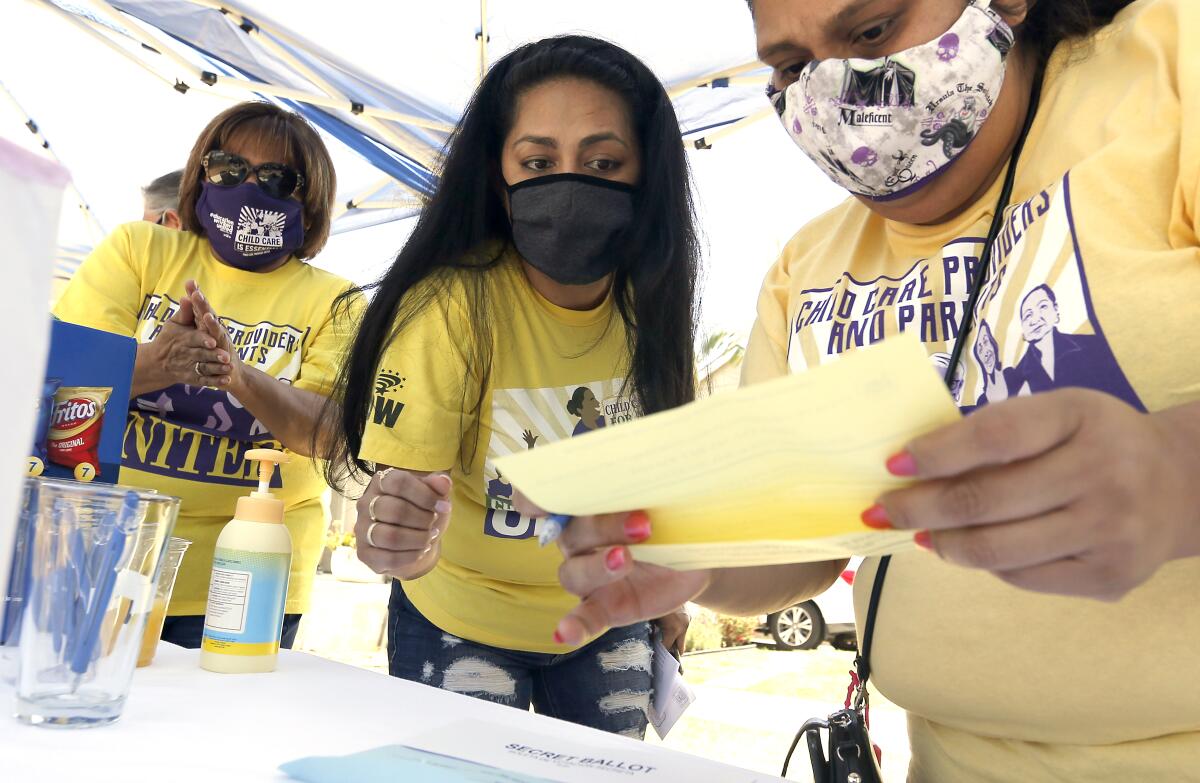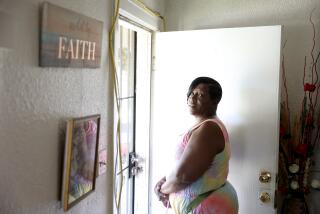Union vote highlights coronavirus crisis for California’s home day-care providers

- Share via
After close to two decades of organizing and legislative struggle, tens of thousands of babysitters, early childhood educators and home day-care proprietors will vote this month on whether to unionize, a move many hope will reinvigorate California’s ailing child-care system in a moment of unprecedented crisis for millions of working families.
“People need to understand, we’re not any regular union,” said Zoila Carolina Toma, a longtime organizer with Child Care Providers United, which could soon represent home-based child-care workers in negotiations with the state. “We’re not just fighting for us as workers; we’re also fighting for our children’s future.”
For the record:
11:32 p.m. July 13, 2020An earlier version of this article referred to the Screen Actors Guild, which is now part of SAG-AFTRA.
As organized labor goes, the guild’s structure is unusual, though hardly unique in California, which boasts one of the highest rates of union membership in the country. Child Care Providers United is run jointly by the state’s two largest unions, SEIU and AFSCME-UDW, but operates more like SAG-AFTRA, which represents independent workers and is an open shop, where membership is voluntary.
Unlike actors, though, day-care workers hope to negotiate directly with the state. California pays, regulates and, in most cases, licenses home-based providers. Union organizers say they want more money, a greater hand in shaping rules and a radical expansion of the state’s alternative payment voucher program for low-income children.
“We want to not just get benefits for ourselves, but also for these families and children,” Toma said. “This will benefit the families we work with.”
The plight of working families has never been more public than it is now, as thousands of parents are being called back to work and thousands more struggle to balance child care with essential jobs. There were about 1 million California children in day care, more than a third of them in subsidized spots, when home-based providers won the right to unionize last fall. The parents who rely on those subsidies are disproportionately working-class Latina and Black women, among those hardest hit by pandemic layoffs.
Unless that care is replaced, experts warn, economic recovery will be impossible. Yet those who provide it say their labor is undervalued and their experiences often outright ignored.
“The default perspective has been, we need to get this child care so that people can go to work, without enough attention to what is actually happening to the workers in those child-care programs,” said Lea J.E. Austin, director of the Center for the Study of Child Care Employment. “We use it, it helps our economy function, but it has largely been invisible to many people.”
In fact, home day-care centers have played an outsize role in the state’s pandemic response, licensing data show. The overwhelming majority stayed open when schools closed in March. They remained open through the spring, as 40% of stand-alone day-care centers shut down, and hundreds of summer camps were forced to cancel. Even emergency child-care programs set up for essential workers have largely become clearinghouses for local home providers.
“We, the day-care workers, we’re supporting those who are on the front line,” said Sylvia Jordan, a provider from Eagle Rock whose charges are the children of nurses, firefighters and security guards. “Not the schools, not the child-care centers — we are the ones who take care of the essential workers.”
That role is born of a brutal financial calculus, Austin said. In L.A. County, most home day-care centers make about $50 per child per day — far less than in other major metro areas. Toma in Signal Hill makes closer to what’s paid in Sacramento than in neighboring Seal Beach, and almost $30 less than in San Francisco.
Most home day-care centers in L.A. are licensed for up to 10 children, so even at full capacity, employing a single assistant at minimum wage could take a third of their income. Providers say mortgages, maintenance, license requirements and materials quickly eat up the rest. In a recent survey of 2,000 California child-care providers, nearly two-thirds of respondents said they would fold if they had to close for more than a month, and 23% said they could not weather a closure of any length.
“Their place of business is also their home — if they have a loss of income, they are at risk of losing their home and struggling to support their own family,” Austin said. “The heart of it is really women having to make choices about their economics over their own health and well-being.”

Like the union effort, those exigencies largely predate the pandemic. But coronavirus has magnified them, providers say. Though lawmakers recently extended a subsidy reimbursements plan based on pre-pandemic attendance, expenses have soared. There is little extra money for sanitizing supplies, materials to support social distancing or food for school-age children, many of whom now fill spots at day care that were previously occupied by infants.
“I’m working more hours with no salary,” said Doris Ruiz, a provider in Long Beach. “It’s hours and hours more that we spend cleaning.”
The squeeze is particularly acute for union hopefuls, as only those who accept state-subsidized children are eligible to vote in the election this month. CalWORKs vouchers, which fund roughly a third of California’s subsidized child care and pay the vast majority of home-based workers, narrowly escaped a 10% cut in the state’s June budget deal.
“I’ve had the opportunity to talk to people who actually make decisions for us, and they are very unaware of what we do,” said Sue Carrera, a union captain in Inglewood who cares for the children of a cargo worker, a grocery clerk and an industrial baker, among others. “For the governor to say he’s going to take 10% [from the subsidy program] — that’s not possible. I won’t be able to take subsidized children. If it comes down to my survival, my hands are tied.”
The voucher program lies at the heart of the organizing effort: Without it, a loose network of small businesses would have little standing to bargain collectively with the state. At the same time, many say its reimbursement rates leave them struggling to provide high-quality care.
“The subsidy rates have been incredibly low, below market in a market that’s repressed as it is,” Austin said. “Providers really have been at a loss to respond to that. Their only option is, don’t serve those children. And they don’t want to be in a position to not serve those children.”
Even if voucher rates remain stagnant, providers say they hope the union will force lawmakers to recognize their value — particularly now, with the future of public schools uncertain and millions of working parents stranded without child care.
“We just want people to understand who we are and how we contribute to the lives of their children,” Carrera said. “We really are essential workers, we’re really important, and we need help.”
More to Read
Sign up for Essential California
The most important California stories and recommendations in your inbox every morning.
You may occasionally receive promotional content from the Los Angeles Times.











